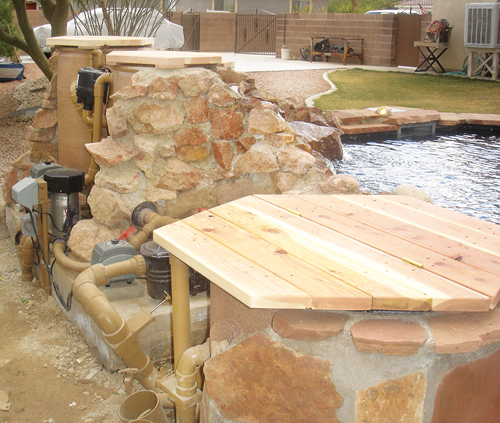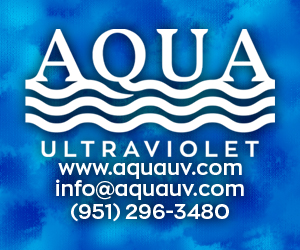This story was originally posted in January 2016.

To be efficient, pond filtration equipment is usually installed as close to the pond as possible. Gracefully concealing your filtration equipment takes as much creativity as building the pond itself. Many times the ability to hide equipment in plain sight aesthetically makes or breaks a pond’s appearance. Customers want to see the pond —not what makes it operate. Skimmers, settlement tanks, prefilters, biofilters, UV lights and pumps are all types of equipment that can be hidden to great effect.
How to Hide Skimmers

Skimmers used on ponds are usually larger than the skimmers used in pool construction. However, many pool-type skimmers are also used on ponds. All skimmers have relatively unappealing covers —especially when incorporated into the landscape design or a formal edge pond. Skimmers that come with lids are obviously plastic in appearance, which leads most pond builders to use a flat stone instead. It’s fairly easy to wrap around the skimmer with decorative rock, but the lid is the real problem.
One solution is to screw thin lath to the surface with stainless steel screws and apply a cementitious faux coating onto it. This takes technique and time but is well worth the effort. A redwood or faux wood lid also works well and weighs less.
Pool-type skimmers are usually smaller in footprint and easier to place a stone cover over, but another option for pool skimmers is a “Pouralid.” Pouralid makes replacement skimmer lids for almost all swimming pool skimmers available. They look like an upside-down lid with a shallow cavity in the top, which can be filled with whatever cement-type deck material matches the surrounding deck. Virtually any faux finish can be poured and formed in the cavity, making them a good choice when used in formal installations.
How to Conceal Tanks and Prefilters
Settlement tanks and in-ground prefilters are a little more difficult to conceal because of their inherent size. Ranging from 2 to 4 feet in diameter, a stone cover is very difficult and heavy. The few lids available for these larger filter tanks are usually just plain, unattractive plastic. To transform these original lids, they can be cut in sections and faux rocked, or a portion of the lid can be left off altogether if it’s on the back side, away from view. A hinged redwood lid is another good option. Raised ponds with the settlement tanks located closeby or attached to the pond are always more visible than tanks placed in-ground. The hinged lid can be part of the pond’s edge or used as a deck area since occasional access is all that’s necessary.

Cutting the center out of the original lid and creating a vented, domed cover is another way to change the look. Vented lids are important because gases can build up inside the tank, creating a smelly situation. Shade cloth comes in a variety of colors, and making a frame and attaching it to the edge of the original lid is time-consuming but doable. A stone finish can be used to camouflage an existing lid, and always remember to vent it to allow the gases to escape. Additionally, the vent creates an easy hand grab for removal when servicing.
A raised pool for a water garden or planter can be constructed over part of the tank as long as there is enough room left for easy access to the prefilter or rotating micro-screen inside it. If a small pool area with plants is built over the tank, a 2-inch drain in the bottom with a threaded plug makes for easy cleaning, flowing directly into the settlement tank.
Conceal Biofilters — The Natural Equipment

Concealing biofilters is where the pond industry has always shined. In the early years, Aquascape introduced the concept of the open waterfall filter, and from that point on our industry has been hiding biofilters inside waterfalls. It is fairly easy because these filters are usually installed above water level, and surrounding them with the rocks, boulders and landscape material to blend them into the landscape is a natural solution. Currently almost every pond filter manufacturer has their own version of a waterfall filter. Many of these come with a spill or weir made of plastic that is unattractive and unnatural-looking. It’s relatively easy to cut off the spill, leaving just the clamping section for the liner or polyurea. This allows the waterfall and spill rocks to be built right up to the filter’s face for a more natural look.
Waterfall filters generally don’t need complete access like settlement tanks do, so it’s easy to cover the front half and build over the top with rocks and plants. A shallow planter covering half of the top is a good way to soften the look of a waterfall, allowing succulents or ground cover treatments to flow down around the falls.!
How to Hide External Pumps and UV Lights

External pumps and UV lights are probably the hardest to hide. External pumps need to be placed in an efficient location between pond and filters. If necessary they can be placed in a large, in-ground landscape valve box or in a box built specifically for them. Fake rocks of hollow plastic can also be used. Any pump box lid or cover should be vented and fake rocks should have holes put in them as vents for a constant flow of cooling air.
Freestanding, large-diameter UV lights can be placed on a slab behind the filters or tubular types can be mounted off the ground, but it’s always a challenge. The electrical portion and power supply must always be located off the ground to prevent moisture contamination. I have modified several single-tube lights for downflow capability so they could be mounted inside a biofilter with the electrical portion above the waterline. This works well if the biofilter is deep enough to allow for it. UV lights can also be buried in the ground, with the electrical portion and bulb access above ground for accessibility.
Put those finishing touches on a build by getting creative, and you can make your equipment covers as beautiful and high-quality as the pond itself.
Kent Wallace is president of Living Water Solutions.


